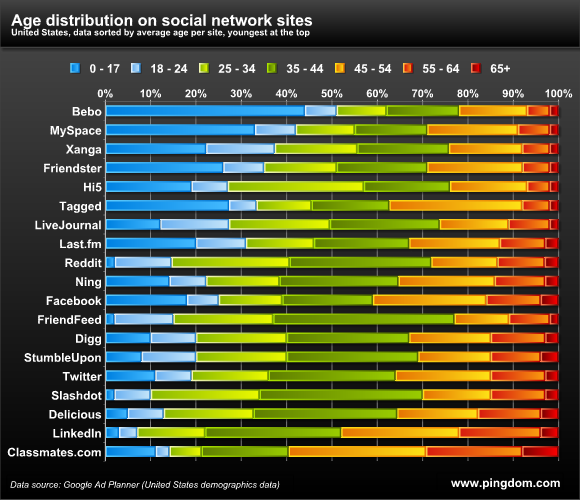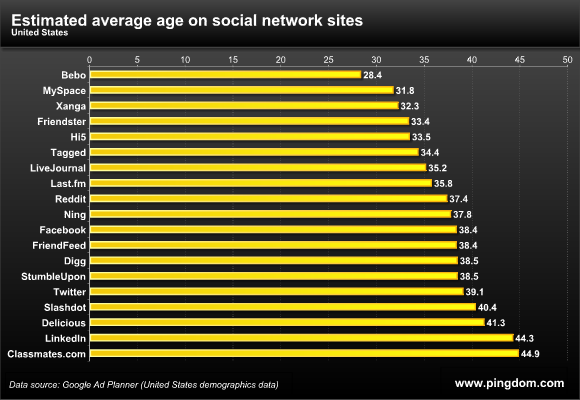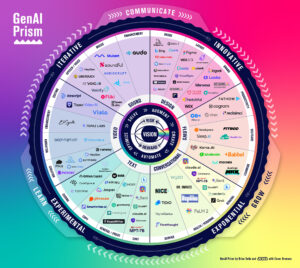
Social networks share a common ingredient in design and intent, the connection of people and the facilitation of conversations, sharing, and discovery. What they do not share however, are culture, behavior, and prevailing demographics. Each network is unique in its genetic and cultural composition and it is for that reason that we benefit by becoming digital anthropologists in addition to new media marketers.
Demographics are distributed within all social networks, but only concentrated within a select few. Where specific demographics materialize varies from network to network and as such, the more effective social strategies and tactics are designed to reach target audiences where, when and how they engage.
Over the years, I’ve relied on Google Ad Planner to surface the critical demographics in order to construct meaningful and targeted social programming. Pingdom recently examined the data and packaged the results in a visually rich presentation worthy of sharing.
The study included 19 social networks…
Bebo
Classmates.com
Delicious
Digg
Facebook
FriendFeed
Friendster
Hi5
Last.fm
LinkedIn
LiveJournal
MySpace
Ning
Reddit
Slashdot
StumbleUpon
Twitter
Tagged
Xanga
Age Distribution

The disposition of age groups within social networking as a whole is representative of the state of social media engagement, but this is fleeting. Age groups will only continue to meander as online networking becomes pervasive. At the moment, we can see that those 35-44 dominate the social web, representing 25% of total participation. For those who have actively monitored adoption of social networks, this next stat might not come as a surprise, but it’s worth highlighting nonetheless. Following at 19% isn’t a younger generation at all, in fact, those 45-54 are the second most active group within social networks, just ahead of the 25-34 segment at 18%. Individuals under 17 rank fourth with 15%. I find it fascinating that the 45 to 65+ group, those who are usually considered laggards in the technology adoption cycle, symbolize almost one-third of total users of social networks. They’re equally connecting with not only each other but also the younger generations who are spending an increasing amount of time online as well.
Distribution of Age Within Social Networks
Reviewing the age groups broadly across social media serves only as a primer to the deeper level of analysis required to identify exactly where we need to connect with target demographics. As such, Pingdom performed the first level of segmentation to showcase how age groups are distributed within each specific social network.

Bebo – Over 40% are 17 and under followed by 35-44 and 55-64 at just under 15% each
Classmates.com – The 45-54 dominate at just over 30% followed by 20% at 55-64 and just under 10% at 65+ (Represents the highest concentration of the older demographics with 78% over 35)
Delicious – Over 25% of users are 35-44
Digg – 35-44 constitute over 25% of the total user base followed by just under 20% at 25-34 (80% of users are over 25)
Facebook – ~25% of users are 45-54 with the 35-44 group at just 20% (61% are 35 or older)
FriendFeed – Shy of 40%, 35-44 represent the majority of users
Friendster – Polar opposites with 25% under 17 and roughly 20% 45-54
Hi5 – 25-34 collectively represent close to 30% of all users
Last.fm – Almost 20% are under 17 with the 35-44 category also representing just under 20%
LinkedIn – Less than 30% are 35-44, 20% are 45-54 and more than 15% are 55-64
LiveJournal -25-34 and 35-44 are tied at 20+% percent each
MySpace – Over 30% of all users are under 17 and slightly less than 20% are 45-54
Ning – 25% of 35-44 and over 60% are 35 and older
Reddit – 30% are 35-44
Slashdot – More than 30% are 35-44
StumbleUpon – The 35-44 segment symbolize just under 30% of all users followed by 25-34 at just under 20%
Twitter – More than 25% of users are 35-44, trailed by the 45-54 group at less than 20% (65% of all users are over the age of 35 with less than 20% representing the 24 and under age groups)
Tagged – Almost 30% are 45-54 and slightly over 25% are under 17
Xanga – Over 20% are under 17
Governing Age Groups
If we further review the data, we can see which age groups are dominant across the social Web

17 and under: 21%
18-24: 0%
25-34: 5%
35-44: 58%
45-54: 16%
55-64: 0%
65 and over: 0%
Average User Age by Network
Cascading further down stream, the data when crunched, reveals the average age per network, which allows businesses to better understand the general user within each.

Bebo – 28.4
Classmates.com – 44.9
Delicious – 41.3
Digg – 38.5
Facebook – 38.4
FriendFeed – 38.4
Friendster – 33.4
Hi5 – 33.5
Last.fm – 35.8
LinkedIn – 44.3
LiveJournal – 35.2
MySpace – 31.8
Ning – 37.8
Reddit – 37.4
Slashdot – 40.4
StumbleUpon – 38.5
Twitter – 39.1
Tagged – 34.4
Xanga – 32.3
In social media, not only do women rule, but it seems that the middle-aged are Social Media’s largest share holders. Again, the average number is just that, a generalization of users classified by age, not by usage, theme, or connectivity. As we identify whom it is we need to reach and why, analyzing data as it relates to age groups is just one side of a multi-faceted program. In order to possess and convey value and meaning, it is anthropology, sociology and the psychographic mapping of people to themes, interests, and aspirations that will prevail now and over time. It’s the difference between visibility and presence, and in social media, presence is felt.
Connect with Brian Solis on Twitter, LinkedIn, Tumblr, Google Buzz, Facebook
—
Please consider reading my brand new book, Engage!
—
Get Putting the Public Back in Public Relations and The Conversation Prism:
Image Credit: Pingdom









Once again, valuable statistics and analysis. Thanks for sharing.
My pleasure Sheila!
Another factor is how effective each group is in using its own channel, i.e. as a means to reach its objective – which of course may differ across each user group.
Good point Ivan…
Invaluable data and great analysis. Thanks again, Brian.
Hey Craig, appreciate it!
Awesome stats Brian. Actually a guy I follow on Twitter (alejandroreyes) and subscribed to his blog (GetInternetFamous), recommended checking out your blog. It looks like as advertising becomes more and more introduced into social networks/social media, whatever people call it nowadays ;-), that the 35-44 age demographic will become the one to go after.
Thanks Mike. Alejandro is a good guy. Thanks for swinging by!
Great analysis, thanks for always sharing valuable information. I'm sure all this information could help many small business targeting their niche market in a better way now.
If you run a startup and have any doubt related to social media marketing you could also post your questions on Startups.com where experts will give you some quick tips and advices.
I'd love to understand how pingdom defines “governing” the social web. What metrics/data indicate dominance? Is that activity or time spent while on social sites? Can you clarify that chart?
As specialists in marketing to Baby Boomers and beyond, we've been tracking and sharing statistics and insights into social media and older Internet users for some time now (http://www.creatingresults.com/knowledge/catego…). This fresh data is very exciting. Thanks for posting!
Brian, this analysis is incredibly helpful. Great charts for me to use with clients in helping them understand where to place most of their efforts.
Thank you Linda. I find it fascinating!
I'm surprised Orkut was not included in the study! It is one of (if not the) most trafficked sites in Brazil. Coincidentally, I notice that several of your reactions are in Portuguese. Was the study only focused on international social networks?
great stats, Brian. My teen daughter is doing a report on the impact of social media on teens. I see from your stats that social networks are mostly people above 17. very interesting..any recommendations on where she might look to learn about the teens as a group? Any stats you can recommend for her to look at?
Hi! Thank you….try this: http://www.pewinternet.org/Reports/2010/Social-…
perfect. thanks. the Pew Research Center has done a number of important studies. I'm happy to know about this one. Thanks for the link.
Brian-great post and info as always. Thanks for the stats and analysis. Cheers!
Nice to know that people who are aged between 35 to 44 are more than any other aged people who are using social networks.
Thank you for the insight. This is very interesting. I'm surprised by the 18-24 year olds. Are they too busy going to university? Or finding a job? Or do they simply got other things to do than virtually connecting with friends/peers…
This is excellent, Brian. Thank you.
As always, very insightful and useful information. Thanks, Brian!
I love that I can always count on you to share fascinating data on your blog. Thank you!
Amazing!The age of social networks is raising with the growing popularity of the social networking sites that helps us to be connected and share each other's thoughts through it.Social media is a good way to network with other professionals.
Farmville Secrets
That 0-17 figure for Tagged is a little scary. I wouldn't consider it a kid-friendly or safe network.
Dear Mr. Solis,
As a student studying public relations, I am very interested in all aspects that deal with new and emerging channels in which to reach consumers the best and one of those new channels is social media. This type of channel fascinates me because there are so many different types of social networking sites, and each site has its own demographic as you have described in your blog. As I keep reading about social networks, I learn more and more about them and I’ve noticed there are many more sites than just the more popular sites such as Facebook, MySpace, LinkedIn and Twitter as you have also mentioned in your blog.
I imagine this research is very helpful for advertisers and public relations practitioners to have handy when talking with current or future clients and trying to figure out the best medium to use in order to get the client’s message out to their target audience. This research you have conducted will allow advertisers and public relations practitioners to delve deeper into social networking sites. I believe they know they need to change with technology and adapt to the newly emerging social networking sites but with this research you have conducted, they now know which sites will contain the majority of their target audience. They will also learn how to conduct research as time goes on and see first-hand how trends of social networking sites may change and thus may affect the way they will conduct business with their clients.
The emergence of social networking sites has given a chance for advertisers and public relations practitioners to personalize messages to audiences by targeting a social networking site like MySpace that has a majority of users under the age of 17. Instead of possibly running a commercial that does not reach the intended audience, a company can just run an advertisement on a social networking site that will be much more likely to reach the intended audience.
I really appreciate your post about social networking sites and how important it is to realize each social networking site has its own demographic and to recognize certain age groups that are getting online that may get overlooked. This is very helpful for people like me who are studying public relations to understand and grasp this concept to be successful in our future endeavors.
Brian, thank you for your work in collecting and exploring these stats … currently speaking for a group here in PDX, and in today’s session one participant was really hot and bothered about how teens just aren’t on social networks (which wasn’t really the gist of the seminar, but I think he saw some sort of an escape hatch for his organization with regard to social by suggesting that the “future” won’t embrace it … **sigh ) I found myself desiring to add a few meaty stats into tomorrow’s planned outline, and of course found my way to your site. Thanks. ~ Gretchen
Good luck!
Nice one good categorization
i don’t understand why 18-24 is less?